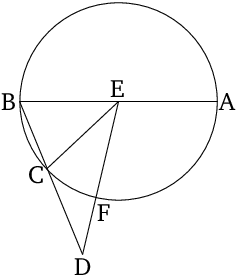Proof: By Euclid
(related to Proposition: Prop. 13.09: Sides Appended of Hexagon and Decagon inscribed in same Circle are cut in Extreme and Mean Ratio)

- For let the center of the circle, point $E$, have been found [Prop. 3.1], and let $EB$, $EC$, and $ED$ have been joined, and let $BE$ have been drawn across to $A$.
- Since $BC$ is a side on an equilateral decagon, circumference $ACB$ (is) thus five times circumference $BC$.
- Thus, circumference $AC$ (is) four times $CB$.
- And as circumference $AC$ (is) to $CB$, so angle $AEC$ (is) to $CEB$ [Prop. 6.33].
- Thus, (angle) $AEC$ (is) four times $CEB$.
- And since angle $EBC$ (is) equal to $ECB$ [Prop. 1.5], angle $AEC$ is thus double $ECB$ [Prop. 1.32].
- And since straight line $EC$ is equal to $CD$ - for each of them is equal to the side of the hexagon [inscribed] in circle $ABC$ [Prop. 4.15 corr.] 0 - angle $CED$ is also equal to angle $CDE$ [Prop. 1.5].
- Thus, angle $ECB$ (is) double $EDC$ [Prop. 1.32].
- But, $AEC$ was shown (to be) double $ECB$.
- Thus, $AEC$ (is) four times $EDC$.
- And $AEC$ was also shown (to be) four times $BEC$.
- Thus, $EDC$ (is) equal to $BEC$.
- And angle $EBD$ (is) common to the two triangles $BEC$ and $BED$.
- Thus, the remaining (angle) $BED$ is equal to the (remaining angle) $ECB$ [Prop. 1.32].
- Thus, triangle $EBD$ is equiangular to triangle $EBC$.
- Thus, proportionally, as $DB$ is to $BE$, so $EB$ (is) to $BC$ [Prop. 6.4].
- And $EB$ (is) equal to $CD$.
- Thus, as $BD$ is to $DC$, so $DC$ (is) to $CB$.
- And $BD$ (is) greater than $DC$.
- Thus, $DC$ (is) also greater than $CB$ [Prop. 5.14].
- Thus, the straight line $BD$ has been cut in extreme and mean ratio [at $C$], and $DC$ is its greater piece.
- (Which is), the very thing it was required to show.
∎
Thank you to the contributors under CC BY-SA 4.0! 

- Github:
-

- non-Github:
- @Fitzpatrick
References
Adapted from (subject to copyright, with kind permission)
- Fitzpatrick, Richard: Euclid's "Elements of Geometry"
